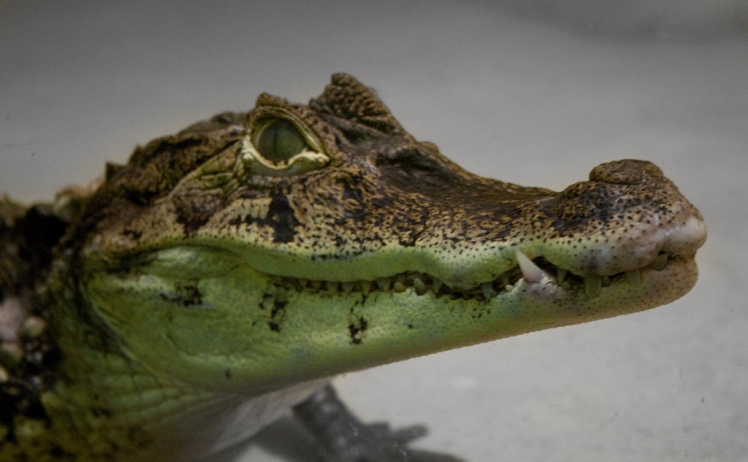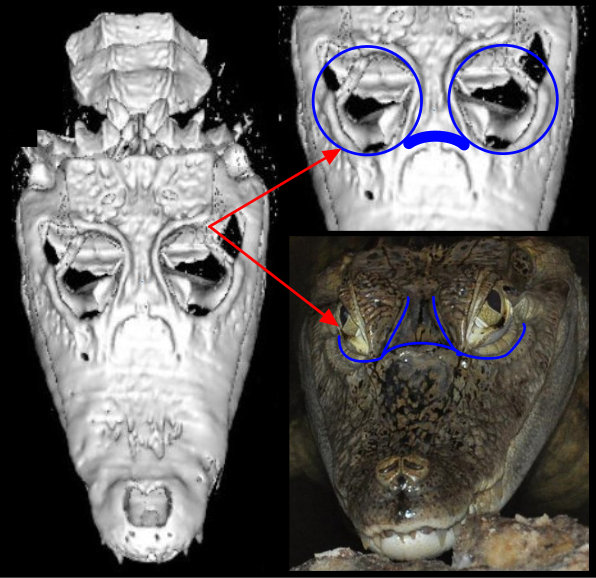
Name: Spectacled caiman (Caiman crocodilus)
Range: From southern Mexico, through Central America and down into tropical South America as far south as Corrientes, close to the Paraguay-Argentina border.
Diet: Carnivorous
Conservation Status: IUCN – Least Concern
The Spectacled caiman is a medium sized crocodilian (~1.8 – 2.5meters) from the family Alligatoridae, which is comprised of two extant (living) species of alligators and half a dozen caimans, of which further extends to a number of subspecies. It gets its name ‘spectacled’ from the bony eye structure. Encircling the eye sockets is a bony ridge that connects the two eyes over the muzzle, just like the bridge on a pair of spectacles, hence the name. Of all the caiman, the spectacled caiman is the most common, having the widest distribution. They are found from southern Mexico, through Central America and down into tropical South America as far south as Corrientes, close to the Paraguay-Argentina border, and from east of the Andes, across the Amazon basin to the Atlantic. They are also found on some Caribbean islands including Trinidad and Tobago. They are renowned for their generalist nature, thriving in a diverse range of habitats and climates including tropical and sub-tropical rainforest rivers and streams, lakes, swamps and also demonstrate tolerance to saltmarsh. They are also a generalist predator, and scavenger, consuming a wide range of animals. As hatchlings, they feed mainly on crustaceans, insects, mollusks and small fish, but as they grow, they increase their prey size, and range, to include crabs, frogs, small deer, capybara, pigs, birds and other reptiles (including other caiman).

Also referred to as the fishing caiman, typically crocodilian, they have a repertoire of fishing techniques. Caiman often try a side snap, or “jumping”. When jumping, they rear up on the hind limbs and align the forelimbs with the torso before launching their bodies up, and then down, into a dive. Their fishing specialist cousins, the Gharials have a very long and slender snout with an abundance of sharp pointy teeth ideal for explosive side swiping and very successful for catching fish. Caiman on the other hand, have a broad snout, less specialized for fishing than the gharial. For a more successful catch, caiman typically ambush fish. The two most successful techniques are trapping and weir fishing. Trapping fish is a surface feeding technique. It is achieved by using their long bodies and tails, they align themselves parallel along the shore, and orientate themselves in a curved position and inch themselves towards the shore trapping fish in the shallow water. As the fish panic, some will try to escape past the head and the caiman will quickly snatch them up their jaws. When weir fishing, the caiman align themselves at a right angle with their heads orientated to the flow of water. The caiman’s body acts as a barrier to fish moving with the current and the angle the caiman is positioned will direct the fish towards the head where it can quickly snap them up.
The spectacled caiman has proved to be resilient against human pressures. They have exceptionally well developed osteoderms in their ventral scales which makes them less attractive skins for tanning. The larger crocodiles and alligators, as well as other caiman species, have superior skins which appeal to the commercial skin trade. Because of this, spectacled caiman avoided the intense hunting for many decades until other species dwindled to dangerously low numbers. Due to the generalist nature of spectacled caiman, they thrived and filled the new niches in regions where sympatric species were significantly reduced. This also inhibited recovery of sympatric species such as the Orinoco crocodile in the Venezuelan Llanos, as competition is intense when the caiman are over populated. Even as spectacled caiman became the new target for the commercial skin trade, harvesting over a million individuals annually they remain strong in numbers to this day in many regions.
Image credits:
